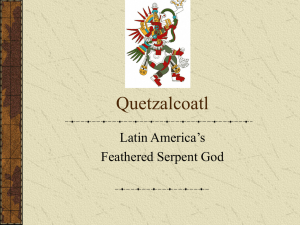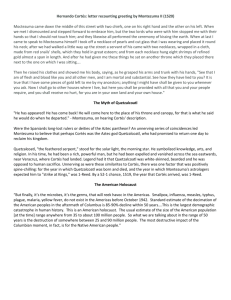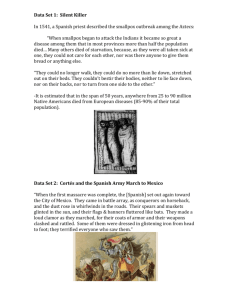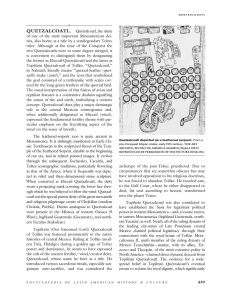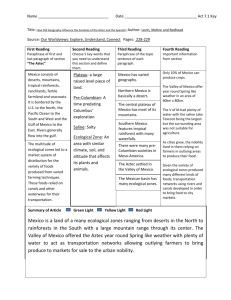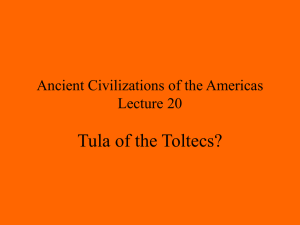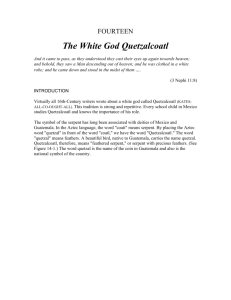CHILDREN OF THE PLUMED SERPENT: THE LEGACY OF
advertisement
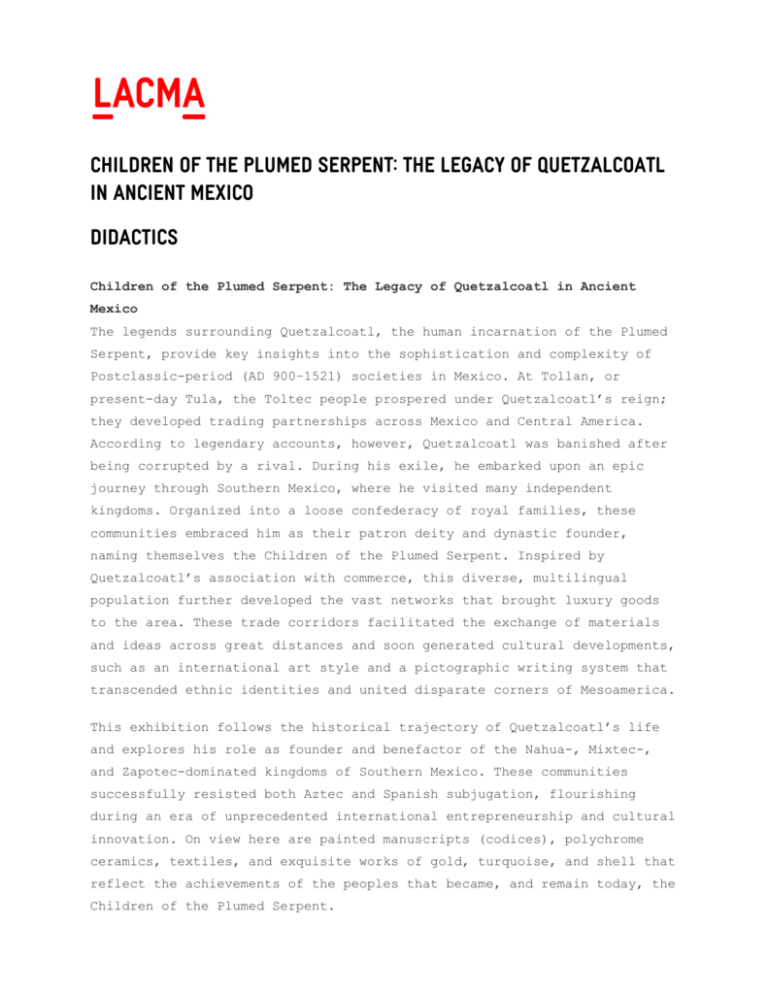
^ CHILDREN OF THE PLUMED SERPENT: THE LEGACY OF QUETZALCOATL IN ANCIENT MEXICO DidacticS Children of the Plumed Serpent: The Legacy of Quetzalcoatl in Ancient Mexico The legends surrounding Quetzalcoatl, the human incarnation of the Plumed Serpent, provide key insights into the sophistication and complexity of Postclassic-period (AD 900–1521) societies in Mexico. At Tollan, or present-day Tula, the Toltec people prospered under Quetzalcoatl’s reign; they developed trading partnerships across Mexico and Central America. According to legendary accounts, however, Quetzalcoatl was banished after being corrupted by a rival. During his exile, he embarked upon an epic journey through Southern Mexico, where he visited many independent kingdoms. Organized into a loose confederacy of royal families, these communities embraced him as their patron deity and dynastic founder, naming themselves the Children of the Plumed Serpent. Inspired by Quetzalcoatl’s association with commerce, this diverse, multilingual population further developed the vast networks that brought luxury goods to the area. These trade corridors facilitated the exchange of materials and ideas across great distances and soon generated cultural developments, such as an international art style and a pictographic writing system that transcended ethnic identities and united disparate corners of Mesoamerica. This exhibition follows the historical trajectory of Quetzalcoatl’s life and explores his role as founder and benefactor of the Nahua-, Mixtec-, and Zapotec-dominated kingdoms of Southern Mexico. These communities successfully resisted both Aztec and Spanish subjugation, flourishing during an era of unprecedented international entrepreneurship and cultural innovation. On view here are painted manuscripts (codices), polychrome ceramics, textiles, and exquisite works of gold, turquoise, and shell that reflect the achievements of the peoples that became, and remain today, the Children of the Plumed Serpent. The World of Tula and Chichen Itza Tula, also known as Tollan, or Place of Reeds, was considered an ancestral place of origin for many of the civilizations of Mexico. The Toltec were revered for their sophisticated culture, wisdom, and skilled artistry— attributes associated with the city’s legendary founder and ruler, Quetzalcoatl, or the Plumed Serpent. Tula would become the seat of Quetzalcoatl’s cult, attracting pilgrims from across Mesoamerica and emerging as a dynamic international center between AD 900 and 1200. Like Tula, the Maya city of Chichen Itza on the Yucatan Peninsula claimed an important relationship to the Plumed Serpent (who was called Kukulcan in Maya), and its art and architecture include numerous depictions of him. As hubs of an extensive web of exchange networks, Tula and Chichen Itza drew merchants and traders from across the Americas. Both cities flourished for over two centuries, until their decline in AD 1200. The archaeological records of both cities reflect their cosmopolitan nature. The Franciscan friar Bernardino de Sahagún wrote that at Tula, the houses of Quetzalcoatl were made of greenstone, gold, turquoise, seashell, and precious feathers. As seen in this gallery, imported goods such as ceramic vessels and gold from Central America, along with turquoise from the American Southwest, are among the rare materials found at each site. The New Tollan: The Rise of Cholula and the Birth of the International Style After the fall of Tula in AD 1200, many Toltecs migrated south to Cholula, where they built a new Tollan. They dedicated the city to Quetzalcoatl, the Plumed Serpent and god of wind, in whose honor they erected a conicalroofed temple. Cholula soon emerged as the center of religious authority in Mesoamerica, and confederations of kingdoms throughout Southern and Central Mexico referred to themselves as the Children of the Plumed Serpent. Cholula was considered the holiest of cities, according to the sixteenth-century Spanish chronicler Gabriel de Rojas, and could be compared to Rome for Christians or Mecca for the Moors. As the most important pilgrimage destination in the region, Cholula became a crossroads for people and goods. The constant flow of exotic materials fostered the development of one of the most significant marketplaces in the Americas, an achievement befitting the city’s deity, Quetzalcoatl, who 2 was also known as the patron of merchants. By the fourteenth century, a new art style had emerged alongside a pictographic system of communication. Known as the International Style, it was characterized by a vivid palette and bold symbols that reduced concepts and spoken words to simple icons in order to promote the exchange of ideas across ethnic and linguistic boundaries. The objects in this gallery, gathered from across Mexico, illustrate the widely shared set of ritual practices and devotions dedicated to key supernatural patrons throughout Mesoamerica. Feasting, Divination, and Heroic History The performance of religious stories as depicted in masterful works of art was an integral part of royal feasts among the Children of the Plumed Serpent. Poets used codices (illustrated manuscripts) like storyboards to recite royal genealogies and heroic histories. Festivities even included a kind of literary symposium in which nobles donned costumes and enacted specific roles, dancing and singing their parts to musical accompaniment. Revelers believed that by drinking to excess with goblets of pulque (a beverage fermented from the agave plant) or eating chocolate along with hallucinogens, they could conjure the dead and commune with their ancestors. They thus could seek advice on the resolution of disputes or the arrangement of favorable alliances through marriages. Feasting was an essential part of alliance building and elite economic exchange. The production of art was directly supervised—if not actually carried out—by men and women of the royal class, thereby creating specialized forms of wealth that only people of noble birth could enjoy and exchange through competitive gift giving at feasts and royal fairs. Finely crafted, polychrome drinking vessels were not only props for the drama of ancestor rituals but also promoted political alliances when given as prized gifts that could later be interred with their owners. Other luxury goods, such as works of precious stone and metal, the feathers of tropical birds, and exquisitely woven and embroidered textiles, served as currency in the buying and selling of prestige and political power. Avenues of Trade and the Spread of the International Style After AD 1200, political power became less centralized in the Southern Mexican highlands. Scores of independent royal houses rose, producing 3 extraordinary, finely crafted jewelry, polychrome ceramics, textiles, and featherwork. These luxury goods moved along strategic alliance corridors through bridewealth, dowry, and other forms of gift exchange. Great houses engaged in fiercely competitive reciprocity systems in order to enhance their position in alliance networks. The greater a royal house’s ability to acquire exotic materials and craft them into exquisite artworks, the better it could negotiate favorable marriages. If it could negotiate more prestigious marriages, then a royal house could achieve a higher rank within a confederacy and, in turn, could gain better access to even more exotic materials, thus continually improving its status. The International Style, which had developed in Cholula by the fourteenth century, was widely adopted and was sometimes called Nahua-Mixteca after the two cultures most responsible for its emergence. With its vocabulary of highly conventionalized symbols in vivid colors, the International Style facilitated information sharing between increasingly far-flung independent states that ranged from the Yucatan Peninsula and highland Guatemala to the Pacific Coast and, ultimately, to the vast reaches of northern Mexico, the American Southwest, and the American Southeast, where exotic materials such as turquoise and shell were exchanged for other elite commodities like cacao and the plumage of rare tropical birds. The Aztec Conquest and the Spanish Incursion By the fifteenth century, a new power had emerged in the Valley of Mexico: the Aztec Empire. Under Ahuitzotl, a ruthless warrior who assumed power in AD 1486, the Aztecs expanded south to dominate the Eastern Nahuas, eventually conquering Cholula as well as the Valley of Oaxaca and the Isthmus of Tehuantepec. The conquest of these Mixtec and Zapotec kingdoms threatened regional alliances; however, the confederacies’ military acumen and deft negotiating enabled them to retain their trading networks. After his entrapment by an allied army, Ahuitzotl agreed to a marriage between his daughter and a local Zapotec prince. The Zapotecs thus achieved a mediated peace, preserving control of the Soconusco region and its prized cacao. Further Aztec conquest ended with the arrival from Spain of Hernán Cortés and his army in 1519. This date corresponds to the year 1 Reed in the Mexican calendar, the year associated with Quetzalcoatl’s mythic birth. 4 Motecuhzoma II, Ahuitzotl’s successor, interpreted the news of the Spaniards’ arrival as the return of Quetzalcoatl and sent gifts to Cortés. Local communities, resentful of Aztec imperialism, readily forged alliances with the Spaniards and soon brought down the Aztec Empire. The southern kingdoms reconstituted their confederacies and trading networks under the new regime and emerged as an integral part of the new economy. Native ruling lords, or caciques, allied themselves with Spanish clergy and acted as intermediaries between the indigenous past and colonial present. Today, descendants of the Children of the Plumed Serpent continue to thrive in Southern Mexico. 5
